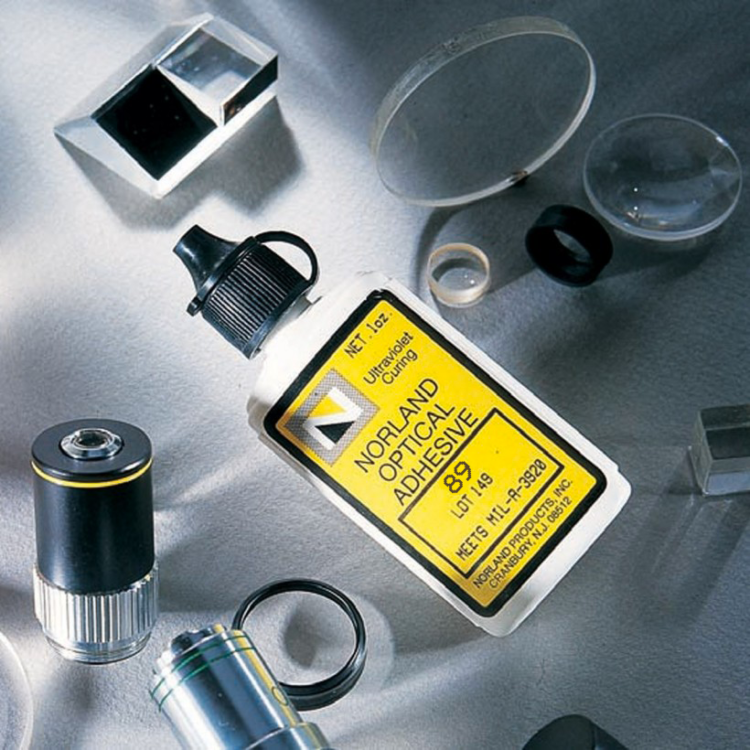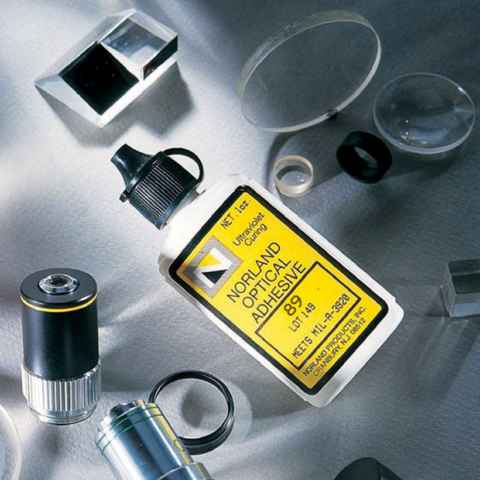Since, it is a one part system and 100% solid, it offers many advantages in bonding where the adhesive can be exposed to UV light. The use of NOA 89 eliminates premixing, drying or heat curing operations common to other adhesive systems. Curing time is remarkably fast, and is dependent upon the thickness applied and the amount of ultraviolet light energy available.
NOA 89 is designed to give the best possible optical bond when bonding glass to glass substrates or as a coating. NOA 89 also has excellent clarity, low shrinkage and a flexibility that make it superior to other materials for optical bonding. These characteristics are important in order for the user to produce high quality optics and achieve long term performance under changing environments.
NOA 89 is cured by ultraviolet light with maximum absorption within the range of 310-395 nanometers. The peak absorption wavelength is 365 nanometers. The recommended energy required for full cure is 3.5 Joules/cm² for long wave UV.
In most optical applications, curing is done in two steps. A short, uniform exposure, or precure, is used first. The precure time is of sufficient duration to set the bond and allow it to be moved without disturbing alignment. This is followed by a longer cure under UV light to obtain full cross-linking and solvent resistance of the adhesive. The precure can be obtained in 15 seconds using a 100 watt mercury lamp at 6″. Where longer time is required for alignment, it can be extended to a few minutes using a very low intensity light source. The final cure can be accomplished in 5 to 10 minutes using the 100 watt mercury lamp.
The precure allows the user to align and set the precision parts quickly, and it minimizes the number of holding fixtures required. After the precure, excess adhesive can be wiped up with an alcohol or acetone moistened cloth. Assemblies should be inspected at this time and rejects separated in methylene chloride. The bonded area must be soaked in the solvent and normally will separate overnight. The time required to break the bond depends upon the extent of the cure and the size of the bond area. Caution should be taken when using methylene chloride as it dissolves many plastics.
Typical Properties of N0A 89
| Refractive Index | 1.51 |
| Temperature Range | -30C to 80°C |
| Viscosity | 15-20 cps |
| Elongation at Failure | 9.5% |
| Modulus (psi) | 4300 |
| Tensile Strength (psi) | 194.5 |
| Hardness- Shore D | 40 |
Shelf life of the liquid is at least 4 months from the date of shipment if stored in a cool (5-
22°C), dark place in the original container. If refrigerated, allow the adhesive to come to room
temperature prior to use.
Care should be taken in handling this material. The Material Safety Data Sheet should be read
for this product as well as for any associated products such as alcohol, acetone or methylene
chloride. Prolonged contact with skin should be avoided and affected areas should be
thoroughly washed with copious amounts of soap and water. If the adhesive gets into the eyes,
flush with water for 15 minutes and seek medical attention. Use the material in a well
ventilated area, otherwise a NIOSH approved organic vapor mask is recommended.



